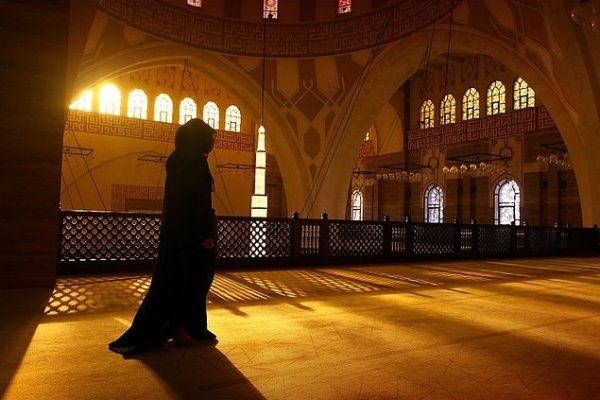What is unique about Islamophobia for women who wear the hijab is that we experience it simultaneously in multiple spaces, burdened with the weight and tarnished with the scars of each experience onto the next.
What is unique about Islamophobia for women who wear the hijab is that we experience it simultaneously in multiple spaces, burdened with the weight and tarnished with the scars of each experience onto the next.
Following the Islamophobic comments made by Prime Minister Boris Johnson, who likened Muslim women to letterboxes and bank robbers, Islamophobic hate crimes increased by a harrowing 375% across the UK, creating fear and anxiety among many British Muslims. A closer inspection of such figures unearths a stark finding; British Muslim women are much more likely to be subjected to such heinous crimes, particularly due to their visibility as hijab (headscarf) wearing women.
While the shift of public and political discourse is rapidly leaning towards the right in which Muslim men and women are being employed as tools for nation-making to implement and justify such directions, the lived reality for British Muslim women at the grassroots level, seldom pierces these very public and political discourses.
“A staff member told me she wanted to burn my scarf when I was changing so I would have no choice but to come outside the changing room without one.”
This was the harrowing account of a British Muslim woman who participated in the world’s largest study I conducted into Muslim women’s experiences of work and career development, which was launched in Parliament in February 2020.
Amongst the 425 survey responses and over 50 one-to-one interviews, the “Empowered Employment” report found that almost half of all women stating they had experienced Islamophobia in the workplace. British Muslim women who were doctors experienced patients who did not want to be treated by them because they were Muslim. British Muslim women teachers faced parents of their students removing them from the class and in some cases, the school, due to not wanting their child to be taught by a Muslim. Another participant told me that she was sacked after she refused to remove her headscarf at work. Some reported receiving anonymous hate mail after terrorist incidents. Others shared instances where colleagues held glasses of wine and alcohol mockingly in their faces during Ramadan.
The relationship between Islamophobia and work and career development for Muslim women, therefore, is acuter than ever before, and being visibly Muslim by way of wearing a headscarf, places women at greater risk.
The tug of war between wearing your religion and being Muslim and being British was also seen in the stark loss of aspiration and talent between the ages of 14-22. For instance, while 79 participants wanted to enter the medical field in secondary school, only 1 participant entered the field as a doctor. Similarly, while 46 participants wanted to become lawyers, only 12 became lawyers upon graduating university, and while 39 participants wanted to become journalists and/or enter the media profession, only 7 entered the profession.
These results show an alarming discrepancy between aspired-to profession and actual profession, which invites a discussion about the challenges and obstacles Muslim women are faced with in this crucial period where women will complete significant educational milestones such as GCSEs, A levels, and university degrees.
For some women like myself, Islamophobia and racism conflate with a specific socio-economic background to exacerbate experiences in education and workplaces. Born and raised in one of the most disadvantaged areas in the UK (Alum Rock, Birmingham), the sheer weight of wearing the hijab in this increasingly right-wing and anti-Muslim climate has been a hallmark of my adulthood thus far.
In 2015, I set out to study my Ph.D. as a 23-year-old, which I decided to fund through employment after I was continuously rejected for scholarships. A week into my employment, a teacher showed a graphic 18-rated video footage of people jumping to their deaths during the 9/11 attacks to a group of 11-year-olds, some of whom had special education needs, and the majority of whom were Black and Minority Ethnic (BAME) children. The white teacher prefaced the showing of the video with “the 9/11 attacks have been written out of history, we must show what the Muslims did to us.” I raised a concern as to the necessity of showing the video to find that 40 minutes later, the school decided to unfairly dismiss me.
This led to me seeking justice in the employment tribunals, for which I won some claims in 2017, but aspects of which are ongoing. The fact that I wore a hijab led teachers to misunderstand my genuine child safeguarding concern for a religious issue. This had a knock-on effect on my Ph.D. studies, for which I was denied support from my university despite the university knowing how rare it was for someone from my background to be studying for a Ph.D.
What is unique about Islamophobia for women who wear the hijab is that we experience it simultaneously in multiple spaces, burdened with the weight and tarnished with the scars of each experience onto the next. For me, I experienced discrimination in the workplace, in the education space, and in the legal space all at the same time, as with many of the women who took part in the study. Borrowing from Stormzy then, “heavy is the head that wears the hijab”, is more fitting of a description for hijab-wearing Muslim women who experience the amplified effects of Islamophobia in contemporary times, from the UK to France, to the USA.
In the report’s findings, I make specific recommendations for employers and workplaces, educational institutions, community organisations, and policymakers, and suggest they form a bedrock partnership to make work and education spaces more inclusive environments for Muslim women.
For employers and workplaces, the recommendations include implementing name-blind applications as part of HR policy and practice, instilling a culture where networking activities take place in non-alcoholic environments, and to issue clear guidelines to all staff as to what comprises Islamophobic behaviour and the steps that will be taken to address such acts of gross misconduct.
For educational institutions, which can collectively take a leading role in implementing the research findings to aid Muslim women’s development before they enter the workplace, it is recommended that targeted careers events for women and their families are offered to increase awareness about a wide variety of career options. Further, it is recommended that universities offer mentoring and development programs for Muslim women, such as the Muslim Women’s Skills Workshops I delivered at SOAS, University of London earlier this year, which were a first for any UK university.
Empowerment must extend beyond lip service, to actual change in structures and systems.





